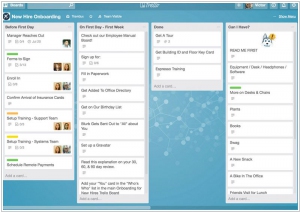Trello vs Wunderlist
March 09, 2025 | Author: Adam Levine
48★
Get organized as fast as you can think. The easy-to-use interface takes no time to learn, and every action is instantaneous, so there’s nothing standing between you and your sweet productive flow. Trello is great alone, but even better with others. Get the whole group onboard in seconds. See their updates in real time.
1★
Wunderlist is the easiest way to manage and share your to-do lists. Whether you’re planning an overseas adventure, sharing a shopping list with a loved one or running your very own business, Wunderlist is here to help you achieve great things.
Trello and Wunderlist, at first glance, seem like two peas in a particularly well-organized pod. Both exist to make you feel like you have your life together, offering digital spaces where you can jot down tasks, set deadlines and share your grand plans with others—who will, of course, ignore them. They live on the web, on your phone and in the back of your mind, nagging you about things you still haven’t done. They even integrate with other software, because nothing says "efficient" like linking your to-do list to the infinite chaos of the internet.
Trello, however, prefers to masquerade as a system of little colored rectangles stuck to an infinite wall, an approach that is either genius or a terrifyingly sophisticated form of procrastination. It was born in 2011 in the United States and, after a brief period of trying to be independent, was swallowed whole by Atlassian in 2017. It thrives on project management and collaboration, making it ideal for teams who want to spend more time arranging tasks than actually doing them. It also features Butler, a built-in automation tool that will happily move your cards around so you don’t have to—because if there's one thing humans need, it's less effort in organizing their own laziness.
Wunderlist, on the other hand, emerged in the same year but from the far more efficient land of Germany, created by a company charmingly named 6Wunderkinder. Its philosophy was simpler: make lists, check things off and bask in the brief glow of productivity. Microsoft, sensing an opportunity to ruin a good thing, acquired it in 2015 and, after a few years of suspense, put it out of its misery by replacing it with Microsoft To Do. It was particularly beloved for personal task management, with smart lists that automatically sorted your responsibilities—assuming you actually wanted to look at them.
See also: Top 10 Productivity software
Trello, however, prefers to masquerade as a system of little colored rectangles stuck to an infinite wall, an approach that is either genius or a terrifyingly sophisticated form of procrastination. It was born in 2011 in the United States and, after a brief period of trying to be independent, was swallowed whole by Atlassian in 2017. It thrives on project management and collaboration, making it ideal for teams who want to spend more time arranging tasks than actually doing them. It also features Butler, a built-in automation tool that will happily move your cards around so you don’t have to—because if there's one thing humans need, it's less effort in organizing their own laziness.
Wunderlist, on the other hand, emerged in the same year but from the far more efficient land of Germany, created by a company charmingly named 6Wunderkinder. Its philosophy was simpler: make lists, check things off and bask in the brief glow of productivity. Microsoft, sensing an opportunity to ruin a good thing, acquired it in 2015 and, after a few years of suspense, put it out of its misery by replacing it with Microsoft To Do. It was particularly beloved for personal task management, with smart lists that automatically sorted your responsibilities—assuming you actually wanted to look at them.
See also: Top 10 Productivity software




